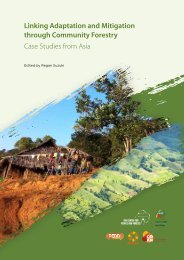Desktop Study on - Regional Climate Change Adaptation ...
Desktop Study on - Regional Climate Change Adaptation ...
Desktop Study on - Regional Climate Change Adaptation ...
Create successful ePaper yourself
Turn your PDF publications into a flip-book with our unique Google optimized e-Paper software.
Assessment of Capacity Gaps and Needs of South East Asia Countries<br />
in Addressing Impacts, Vulnerability and Adaptati<strong>on</strong> to <strong>Climate</strong> Variability and <strong>Climate</strong> <strong>Change</strong><br />
<strong>on</strong> geographical situati<strong>on</strong>s. The UK<br />
Meteorological Office identifies that<br />
climate change causes a decrease of<br />
crop harvest in West Java and East<br />
Java (Amin, 2004 cited in PEACE,<br />
2007). Specifically, a 30-day delay of<br />
m<strong>on</strong>so<strong>on</strong> will reduce January-April<br />
rice producti<strong>on</strong> in West/Central Java<br />
by about 6.5% and in East Java/Bali<br />
by 11% (Ministry of Envir<strong>on</strong>ment,<br />
2007). Also, the UNDP study shows<br />
that the areas highly vulnerable to<br />
climate change are some upland<br />
regi<strong>on</strong>s whose soil cover is projected<br />
to reduce due to the soil erosi<strong>on</strong><br />
caused by the change in rainfall<br />
pattern (2007). The yield of upland<br />
crops such as soybean and maize<br />
could decrease by 20 to 40 percent,<br />
and this agricultural pressure has<br />
significant implicati<strong>on</strong>s for nati<strong>on</strong>al<br />
food security. While the harvest<br />
failure was 100,000 t<strong>on</strong> per district<br />
during 1981 - 1990, it reached<br />
300,000 t<strong>on</strong> in the period of 1991 - 2000 (Boer and<br />
Las, 2003, cited in Republic of Ind<strong>on</strong>esia, 2007).<br />
Climatic threats therefore endanger Ind<strong>on</strong>esia’s<br />
agriculture development program that aims to<br />
increase food security and to increase farmer welfare<br />
(Republic of Ind<strong>on</strong>esia, 2007).<br />
In Central Sulawesh, farmers suffer from the ENSOrelated<br />
drought (Keil et al., 2008). 82% of the<br />
enquired households have already been affected by<br />
excepti<strong>on</strong>ally l<strong>on</strong>g dry periods, especially in the years<br />
of 2002 and 1997/98. The most severely affected<br />
crops in the regi<strong>on</strong> were irrigated rice and cocoa,<br />
declining of yield to 64% and 62% respectively,<br />
compared to no ENSO affected years.<br />
Vulnerability and Adaptati<strong>on</strong> in the<br />
Agriculture and Food Security Sector<br />
At the time of dry seas<strong>on</strong>, some downstream farmers<br />
adapt to the water shortage through pumping<br />
groundwater, which is increasingly polluted by<br />
intrusi<strong>on</strong> of seawater. In some districts, the farmers<br />
resp<strong>on</strong>d to water dispute and tensi<strong>on</strong> am<strong>on</strong>g<br />
farmers through choosing <strong>on</strong>e of their traditi<strong>on</strong>al<br />
respected leaders as a mediator. Through reliance<br />
<strong>on</strong> the traditi<strong>on</strong>al scheme, they ensure their turn for<br />
water (UNDP Ind<strong>on</strong>esia, 2007). These practices are<br />
ex-post strategies that are applied <strong>on</strong>ly for the short<br />
term soluti<strong>on</strong> <strong>on</strong> climate change impacts. The study<br />
of Keil et al. (2008) found out that <strong>on</strong>ly 24% of the<br />
sample households employ ex-ante strategies for the<br />
Figure 28: Example of l<strong>on</strong>g term plan for adaptati<strong>on</strong> for<br />
the agricultural sector (Boer, 2007 cited in<br />
Ministry of Envir<strong>on</strong>ment, 2007)<br />
case of drought c<strong>on</strong>diti<strong>on</strong>s, including to have food<br />
stocks (62% of these households) and to realize cash<br />
savings (31%).<br />
Meanwhile, some researchers and organisati<strong>on</strong>s have<br />
developed the framework of l<strong>on</strong>g term adaptati<strong>on</strong><br />
strategies and introduced the community-level<br />
adaptati<strong>on</strong> practices to farmers in Ind<strong>on</strong>esia. Boer<br />
et al., suggested the planned adaptati<strong>on</strong> strategies<br />
for over the next 30 years, starting from cropping<br />
pattern and irrigati<strong>on</strong> facility adjustment followed<br />
by policy set-up for c<strong>on</strong>versi<strong>on</strong> of rice field to other<br />
sues in Java and development of new irrigati<strong>on</strong><br />
facility in vulnerable areas for rice producti<strong>on</strong><br />
(Ministry of Envir<strong>on</strong>ment, 2007). This example of<br />
l<strong>on</strong>g term adaptati<strong>on</strong> plan is illustrated here with a<br />
time line till 2030 (Figure 28).<br />
The ADPC assists in the instituti<strong>on</strong>alizati<strong>on</strong> of climate<br />
informati<strong>on</strong> applicati<strong>on</strong> for many sectors including<br />
the agriculture sector (Boer et al., 2006). The ADPC<br />
identifies the barriers against reducing farmer’s<br />
vulnerability to extreme weather events: difficulty<br />
in understanding climate forecast informati<strong>on</strong><br />
that c<strong>on</strong>tains probability; lack of effective climate<br />
informati<strong>on</strong> disseminati<strong>on</strong> system; limited capacity<br />
to implement climate forecast in practical use; and<br />
missing awareness <strong>on</strong> the ec<strong>on</strong>omic significance<br />
of climatic forecast informati<strong>on</strong> (Boer et al., 2006).<br />
In order to tackle these barriers, a focus is placed<br />
<strong>on</strong> increasing rice farmer’s knowledge <strong>on</strong> climate<br />
informati<strong>on</strong> applicati<strong>on</strong> through the <strong>Climate</strong><br />
77

















